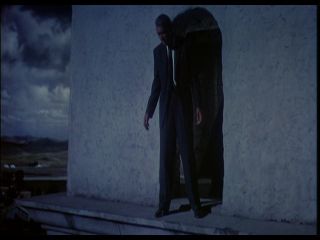The MacGuffin: News and Comment (28/Jun/2008)
(c) Ken Mogg (2008)
June 28
The 'theatrical occasion', in the hands of a knowing playwright or filmmaker, can be imbued with eroticism (see above, on Psycho, et al.). This week I want to relate such a topic to 19th-century precedents for Hitchcock's Vertigo (1958), notably Wagner's opera 'Tristan und Isolde' (1865) and Henrik Ibsen's 'symbolic' last plays, especially 'The Master Builder' (1892). 'Tristan und Isolde' (by Hitchcock's favourite composer) has been described as 'on the surface a celebration of unbridled sensuality' (Barry Millington, 'Wagner', 1984, p. 229) and - not least because of its use of the 'unresolved chord' - a 4½-hour exercise in suspense. Also, critics are generally agreed that 'Tristan' is the Wagner opera that owes most to the notion of the inimical cosmic Will (life/death 'force'), as propounded by the philosopher Arthur Schopenhauer. Now let's consider Ibsen's 'The Master Builder', with its tower climax. As I recently pointed out to our 'Seriously Alfred Hitchcock' Yahoo Group, it's almost unthinkable that Hitchcock, an inveterate play-goer, would not have seen and been influenced by the plays of Ibsen, who almost single-handedly transformed the 19th-century theatre. (As early as 1891, in 'The Quintessence of Ibsenism', George Bernard Shaw was commending Ibsen's plays to English audiences.) Something that struck me about 'The Master Builder' was its 'biographical' elements (on which more in a moment) and also its opposing of 'duty' to 'joy'. The master builder Solness is married to the boring Aline who constantly refers to her 'duty' to be a good bourgeois. Well, in an earlier Ibsen play, 'Rosmersholm'/'The House of Rosmer' (1887), there's the famous line, 'The [dutiful] Rosmer way of life does ennoble ... but it kills joy.' And 'The Master Builder' takes up that idea. Solness, a genius, has begun to feel his powers flagging. Casting around for some means to fulfil his inner vision, and maintain both his sexual and creative energy, he is inspired - to his death, ultimately - by the young woman Hilde who has idolised him since she was a young girl. Ibsen translator James McFarlane writes: '"The Master Builder" ... is the product of a mind deeply preoccupied with the nature of power ... [and is] a study in the erotic. Potency, the capacity to exert some inherent power, is the theme to which the events ... constantly relate.' Perhaps it's merely a coincidence that in 1891, when he was 63, Ibsen had an emotional involvement with 27-year-old Hildur Andersen, a concert pianist, whom he had met when she was 10. (Another famous Ibsen translator, and Ibsen biographer, Michael Meyer, casts doubt on attempts to link Hildur Andersen with the character Hilde.) What isn't in dispute is how the play opposes 'duty' to 'joy' - of various kinds, both sexual and spiritual - and suitably climaxes when Solness climbs the tower of a newly-erected villa to place a garland of greenery there - and falls to his death. The villa's tower recalls the church tower where Hilde, aged 13, had first seen Solness, and afterwards - some scholars suggest - had her first orgasm. Nor can it be denied, I think, that there are several parallels in some of this with Hitchcock films, notably of course Vertigo. While the film's Coit Tower is an obvious phallic symbol (which Hitchcock relished), the connotations of towers and 'ascent' accrue throughout the film, suitably culminating in the tower scene at the Mission San Juan Bautista - where Scottie (James Stewart) finally loses the woman Judy/'Madeleine' (Kim Novak) who had been his 'second chance' (see frame-capture below). The ambiguity of Judy's fall to her death, after she has been frightened by a black-garbed 'mother superior' (note: Aline Solness in 'The Master Builder' is also dressed in black during Act III), has its correspondence in the multivalence of Ibsen's climax. Further, the film's Midge (Barbara Bel Geddes), who has become over-attached to Scottie with little prospect of a sexual relationship (since they broke off their engagement back in 'good old college days'), is effectively another symbol of sterile 'duty' (wasting her time 'in the underwear department', as Scottie puts it, referring to her commercial graphics), and another mother-symbol ('Mother's here', she tells Scottie after he suffers a breakdown mid-way through the film). By contrast, Judy/'Madeleine' is the film's (and Scottie's) 'potency' symbol. (For correspondent JG, I would add this. We agree, I think, that Hitchcock's films are about the life/death force, and I have shown how this applies to The 39 Steps [1935], with its motif of 'quickening'. In particular, the music for the life-goes-on shot of the chorus girls at the end, while Mr Memory - another victim of 'duty', as Hitchcock himself told Truffaut - lies dying, is taken from the film Evergreen [1934]. That is, until the music segues into a few bars from the song "Ain't She Sweet" as Hannay leaves with Pamela in the film's last shot. Anyway, compare the green garland that Solness carries up the tower at the end of 'The Master Builder' ...) Interestingly, Dr Muriel Bradbrook notes that the 'two thinkers who influenced Ibsen most profoundly, Kierkegaard and Schopenhauer, both stressed the doctrine of the Will' ('Ibsen the Norwegian', 1966 edition, p. 14n). And, describing a long dialogue passage between Solness and Hilde in Act II of 'The Master Builder', she calls it 'a sustained love duet in the manner of [Wagner's] "Tristan" ...' (p. 128). QED. More another time.
This material is copyright of Ken Mogg and the Hitchcock Scholars/'MacGuffin' website (home page) and is archived with the permission of the copyright holder. |

